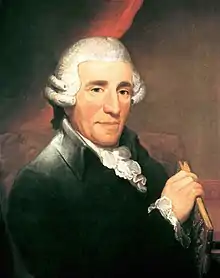Fantasia in C major (Haydn)
Fantasia in C major, Hob. XVII/4, "Capriccio", was written by Joseph Haydn. It is based on the Austrian folk song D’ Bäurin hat d'Katz verlor'n ("The farmer's wife has lost her cat").[1]

In March 1789, he wrote to the publishing company Artaria, saying, "In a moment of great good humour I have completed a new Capriccio for fortepiano, whose taste, singularity and special construction cannot fail to receive approval from connoisseurs and amateurs alike. In a single movement, rather long, but not particularly difficult."[2] The fact that Haydn wrote the fantasia "for connoisseurs and amateurs alike" was most likely a nod to C. P. E. Bach's Für Kenner und Liebhaber ("For Connoisseurs and Amateurs") that he had requested from Artaria the year before.[3] However, the piece was more difficult than Haydn thought it would be, with zany virtuosity and orchestral effects, recalling the last movement of his Sonata No. 48.[1]
References
- Wigmore, Richard. "Fantasia in C major Capriccio, Hob XVII:4". Hyperion Records. Retrieved 6 November 2016.
- Kahn, Elizabeth; Kahn, Joseph. "Capriccio (Fantasia) in C major, Hob.XVII/4" (PDF). Spivey Hall at Clayton State University. Retrieved 6 November 2016.
- Richards, Annette (2007). The Free Fantasia and the Musical Picturesque. Cambridge University Press. p. 125. ISBN 9780521027533.
External links
- Fantasia in C major, Hob.XVII/4: Scores at the International Music Score Library Project
- Fantasia in C major on YouTube, Aris Alexander Blettenberg